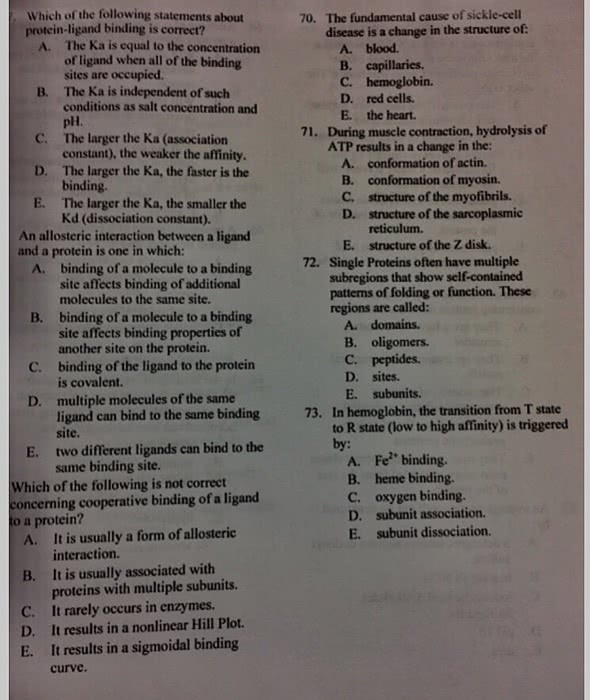Biochemistry 2280A Lecture Notes - Lecture 1: Type I Collagen, Scleroprotein, Collagen

Topic 4
Proteins that are not rigid can undergo modest changes in structure called
“conformational changes” → Conformational changes can be caused by minor changes
in the environment, or by binding of some other molecule, and often involve changes in
the relative position of structural domains
Conformational changes provide the driving force behind motor proteins, the sensory
function of receptors, the control of enzyme activity, the transmission of signals, etc
Generally, a small area of the protein surface is complementary to the structure of
another molecule (called a “ligand”) → in the case of enzymes, this area is termed the
“substrate-binding site” or just “active site”
A protein can have multiple ligand binding sites that may interact so that binding of one
ligand affects the binding of another
Ligand binding is characterized by a dissociation constant, Kd, whose value is
calculated from the affinity of the molecules for each other → Kd =
[Proteinfree][Ligandfree]/[Protein-Ligand Complex]
Kd’s in biological situations range from femtomolar (very high affinity) to millimolar (low
affinity)
Collagen is an example of a fibrous protein → Collagen is actually a family of proteins:
collagen I, II, III, IV, etc. → Various genetic diseases arise from mutations in one of the
collagen genes
Collagens have an unusual amino acid composition. All 20 aa are present, but
collagens are extremely rich in glycine; in fact, every third amino acid residue in the
sequence is glycine. Furthermore, collagen also has a very high proline content (about
20%)
Antibodies are proteins produced by the immune system that bind tightly and
specifically to foreign substances introduced into the body → Because of their amazing
selectivity, antibodies have become powerful tools in medicine (including as drugs) and
for studying proteins
Enzymes are biological catalysts, responsible for directing the flow of chemical
reactions that is the basis for life → By far the majority of enzymes are proteins, but
some consist of RNA or a complex of protein and RNA
Enzymes, as catalysts, are not themselves changed by the reaction although they may
change transiently during the reaction → They often cause huge rate enhancements
(quadrillion-fold or more) but do not affect the basic driving force (thermodynamics)
behind chemical transformations
find more resources at oneclass.com
find more resources at oneclass.com
Document Summary
Proteins that are not rigid can undergo modest changes in structure called. Conformational changes conformational changes can be caused by minor changes in the environment, or by binding of some other molecule, and often involve changes in the relative position of structural domains. Conformational changes provide the driving force behind motor proteins, the sensory function of receptors, the control of enzyme activity, the transmission of signals, etc. Generally, a small area of the protein surface is complementary to the structure of another molecule (called a ligand ) in the case of enzymes, this area is termed the. A protein can have multiple ligand binding sites that may interact so that binding of one ligand affects the binding of another. Ligand binding is characterized by a dissociation constant, kd, whose value is calculated from the affinity of the molecules for each other kd = Kd"s in biological situations range from femtomolar (very high affinity) to millimolar (low affinity)


